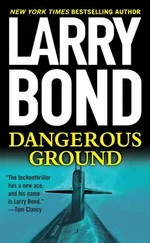The captain took in the report while maintaining full eye contact with Palmer, who fidgeted under his CO’s scrutiny. Although Rudel already knew everything that his JOOD had just told him, it was navy procedure to go over it again to ensure that everyone in the ship’s control party was operating with the same information — especially the junior members. He then glanced over at the ballast and ship control panels to verify the boat’s readiness to submerge. Satisfied, he turned and looked toward Jerry.
“Navigator?”
Jerry answered, “Mark the dive point, sir.”
“Very well, Mr. Palmer. Submerge the ship to one five zero feet.” In spite of the bustle, Rudel spoke in a conversational tone. Palmer echoed the captain’s order, “Submerge the ship to one five zero feet, aye.” Reflexively, Jerry checked the ordered depth against their plotted position and the fathometer. Plenty of room — now over three hundred fathoms, or eighteen hundred feet, beneath them.
Palmer then passed the order on to the diving officer, who in turn leaned forward and repeated it to the planesman and the chief of the watch. The three men echoed it back in unison. Six back-and-forth repetitions of the exact same simple order might seem a little tedious, but well-drilled procedures weighed lightly compared with the price of a mistake.
“Dive! Dive!” announced the chief of the watch over the 1MC, the ship’s main announcing circuit, followed immediately by two blasts of the diving alarm. WREEEEEE, WREEEEEE.
“Dive! Dive!” he announced a second time.
Once the word had been passed that boat was about to submerge, the diving officer paused momentarily, waiting. After about ten seconds, he looked over at Palmer, who was at the number two periscope looking forward. “Off’sa’deck, request ahead two-thirds.”
“What?” responded Palmer, puzzled.
Hayes quickly came beside him and whispered, “We need to slow down, Mr. Palmer. It won’t do to bend a periscope on our way out now, would it?”
“Yes, sir. I mean, no sir,” Palmer replied. Then, struggling to regain his composure, he said, “Helm, all ahead two-thirds.”
“All ahead two-thirds, helm aye.” Reaching down to the engine order telegraph, the petty officer rotated the handle that shifted an arrow from “Flank” to “2/3.” A second arrow on the dial soon followed suit. “Maneuvering answers ahead two-thirds.”
“Very well,” said Palmer, followed immediately with, “Thanks, Dive.”
Acknowledging the comment with a nod, the diving officer proceeded with the business at hand. “Chief of the Watch, open the forward main ballast tank vents.”
“Open the forward main ballast tank vents, aye.” A few toggle switches later, the green bars shifted to red open circles on the ballast control panel or BCP. “Diving Officer, forward main ballast tank vents indicate open.”
Palmer trained the periscope forward and rotated the optics downward. Six towering geysers of air and water vapor leapt from openings on Seawolf’s bow as seawater rushed into the ballast tanks from below and pushed the air out through the vents. “Venting forward,” he reported.
“Venting forward, aye,” responded the diving officer. “Open aft main ballast tank vents.”
“Open the aft main ballast tank vents, aye.”
Rotating the periscope around toward the stern, Palmer saw a similar eruption from the four after vents. “Venting aft.”
Unlike World War II fleet boats that were designed to quickly flood their ballast tanks and “crash dive” under the waves in less than a minute, Seawolf took her sweet time getting under. Like all nuclear-powered submarines, she was designed to stay submerged for long periods of time and wasn’t burdened with the need to surface often like the older diesel boats. The requirement for rapid submergence had been replaced by virtually unlimited underwater endurance and high speed. Furthermore, Seawolf was four times the size of a fleet boat and the increased tankage just took longer to fill. When the time came to submerge, Seawolf’s ort of waddled her way down, but once all the way under she transformed into a graceful sea creature, completely at ease in her element.
“Rig out the bow planes,” ordered the diving officer.
As the ship control party continued with the diving procedures, Jerry watched Palmer supervising the evolution. One of Jerry’s duties as the senior watch officer was to provide the XO with an evaluation of Palmer’s performance, and he wanted the report to be based on factual observations, not fantasy. So far, Palmer seemed to be doing okay. Not great, but okay.
A couple of mechanical clunks told Jerry that the bow planes had been extended and locked. After a quick test, the helmsman was ordered to put ten-degree dive on the bow planes. The effect was immediate as the planes forced Seawolf’s bow downward, driving her under the waves. The video monitor showed the forward part of the hull burrowing deeper into the ocean; the venting geysers becoming more of a bubbling mass.
While the view was spectacular, it was also unnerving. Palmer should be doing 360-degree scans as the boat dove. Once again he had allowed himself to become fixated on a single aspect of this highly complex process. Jerry wasn’t concerned for the safety of the ship, as Hayes was on number-one scope and was keeping a vigilant circle search, but the lack of attention on Palmer’s part didn’t encourage confidence in his abilities. And if the captain didn’t have confidence in a JO, he wouldn’t get qualified. Fortunately, Hayes quickly recognized what was not happening and coaxed Palmer to resume a proper search.
Jerry’s brooding was interrupted by the diving officer’s next report: “Off’sa’deck, stern planes tested sat. I have the bubble, sir. Stern planes to ten-degree dive. Proceeding to ten-degree down bubble.”
“Very well, Dive,” replied Palmer.
With the stern planes in the act, the deck started to dip toward the bow. The force of the water on the depressed stern planes quickly caused the boat’s hull to rotate downward, driving her under the sea. The diving officer watched both the gauge on the ship control panel and the inclinometer attached to the bulkhead. Like a carpenter’s level, a gas bubble indicated the amount of the ship’s tilt as it approached the ordered ten-degree down angle. The reference to the ship’s angle by the position of the “bubble” was firmly rooted in submarine tradition, if somewhat antiquated.
“Depth five five feet,” called out the diving officer.
Palmer acknowledged the report as he kept up his circle search. Going around and around on the periscope, while necessary, was also tedious and somewhat tiring, even with a power assist to help turn the scope. “Dancing with the fat lady,” as the periscope watch was called, could give a person a good workout.
“Depth six zero feet.”
“Decks awash,” Palmer reported.
The diving officer kept on announcing the increasing depth, and after the seventy-foot mark, Palmer announced, “Scopes under. Lowering number-two scope.”
Simultaneously, Hayes lowered the number-one periscope. From start to finish it had taken Seawolf almost eight minutes to dive. Pretty much par for the course, thought Jerry as the quartermaster noted the time in the ship’s log.
Ten minutes later, Seawolf was at 150 feet and with a satisfactory slow speed trim. All balanced out and in her natural environment, she could now truly begin their journey north.
Jerry listened as the captain set Seawolf’s course and speed in a north-easterly direction at sixteen knots. By reflex, he double-checked the plotted course against the captain’s orders. Open water lay before them for hundreds of miles. He noted that the time of the next course change was several days away.
Читать дальше












